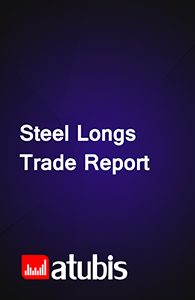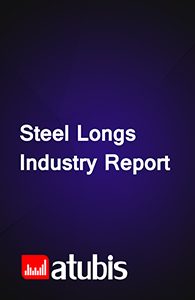Oman’s Steel Rebar Market Outlook Report
9,713€
- TRY: 475,000 ₺
Steel rebar is produced in different diameters according to the intended use. Steel bars are also produced as mild steel plain bars (without ribs). Rebar is packed as irregularly wound coils or bars. Carbon steel rebar is the most commonly used type in construction. Rebar is used in reinforced concrete to improve tensile strength. The construction industry is the largest consumer of rebar in columns and frames for residential and industrial buildings as well as hospitals. Estimates suggest that Oman’s rebar market will have relative growth and oversupply in the coming years.
Product Description
With a per-capita GDP of $32,400 in 2019, Oman was the fifth largest economy in the region that year, behind Qatar, the United Arab Emirates, Bahrain, and Saudi Arabia. The country’s economy has steadily grown over the past years, and according to the Oman Vision 2040, economic growth is expected to continue over the coming years. The country’s logistical location that connects the Gulf Cooperation Council (GCC) countries to the world is one of the major factors in expanding its relations and trade with other countries; the free trade agreement with the US since 2009 is one example. Oil and petrochemicals account for a major portion of the country’s exports. In 2019, about 70% of the country’s total export revenues came from oil and oil-related products. The iron and steel industry in Oman is an emerging business with a history shorter than a decade. Still, total exports of the industry take the second largest share in the country’s export revenues, behind oil products.
Market drivers of Oman’s steel rebar
Owing to its logistic location that provides access to Arab states of the Persian Gulf for producers from far away, Oman has become an attractive venue for foreign investment. On this basis, the country’s iron ore pellet production was developed through a joint venture with the Brazilian Vale. Thus, the development of the iron and steel industry in other countries in the region can help realize one of the goals of the joint venture. Specifically, the completion of the Gulf Railway project that connects member states of the Gulf Cooperation Council will accelerate the achievement.
Despite the growth of the manufacturing sector’s share in the country’s economy over the past years, the share is still small. Added value from the manufacturing sector in 2019 only accounted for 10% of the country’s GDP, which is small compared to other countries in the region. Moreover, the country’s small population has translated into a weak domestic demand. These factors are restricting the growth of crude steel demand in the country. The consumption of steel rebar in the construction industry is the most important application of the product; the mechanical properties of steel rebar have resulted in considerable demand.
Oman reported its first case of Covid-19 in late March 2020. Before long, in April, social distancing and lockdowns were implemented. As a result, the country’s mobility index dropped more than 30%. As the pandemic continued to spread, lockdowns were extended into mid-April, but activities were gradually resumed under certain protocols. Lockdowns are expected to continue, significantly disrupting industrial performance and eventually leading to a decline in demand for iron and steel; a recovery might be likely in the near term.
Overview of Oman’s steel rebar market
A look at the capacities, output, and consumption of steel rebar in Oman shows that the market is an emerging one with a history shorter than 5 years. As rebar capacities were developed, Oman’s imports declined and exports were ramped up. Exports are mostly shipped to Egypt, while Iran is the major import source. Given the slow growth rate forecast for the country’s downstream steel sectors, net exports in the short term are expected to remain around the levels seen in the latter years of the timeframe, but gradually decline afterwards.
Breakdown of Oman’s steel rebar market
Domestic demand for steel rebar in the forecast timeframe as well as the previous period has been broken down using three factors. The first factor breaks down the market into three categories: carbon steel, alloy steel, and stainless steel. Past and future trends for each type of material have been analyzed. Carbon steel rebar holds the largest share of the market. In the second breakdown, products are distinguished based on type: plain, round bar (without ribs) and deformed rebar, with the latter taking the largest market share. Finally, using the third factor, steel rebar is categorized based on its applications in different industries. The construction industry is the largest consumer of steel rebar in Oman.
Key players in Oman’s steel rebar market
- Modern Steel Mills L.L.C
- JINDAL SHADEED IRON & STEEL LLC.
- Muscut Steel Industries
- Sohar complex
Additional Information
| Industry | Steel Rebar |
|---|---|
| Region | Oman |
| Report Type | Industry Report |
Specifications
| Report Attribute | Details |
| The base year for estimation | 2020 |
| Historical data | 2010-2019 |
| Forecast period | 2020-2025 |
| Quantitative units | Value in USD and Volume in Tonne |
| Report coverage | Market Overview, Dynamics, Market Outlook, Risks to Forecast, Consumer Market, Industry Overview, Market Landscape, Competitive Landscape, Market Attractiveness, External Macro Environment Analysis |
| Segments covered | Composition, Type, Application |
| Pricing and purchase options | Please explore our purchase options to meet your exact research needs. |
Reasons to Buy
- Recognize the geographical distribution of import demand
- Identify the current and future key players of the trading market
- Achieve a better insight on potential target markets
- Understand the behavior of major suppliers/customers either globally or regionally
- Identify competitors as a feed for market analysis
Table of Content
- Executive summary
- Introduction
- Objective
- Market under study
- Product
- Product specifications
- Consumption structure
- Applications
- Physical properties
- Subjects discussed
- Geographical scope under study
- Study timeframe
- Study currency
- Potential audience
- Market dynamics
- Market drivers
- Restraints
- Opportunities
- Challenges
- Market overview
- Market size
- Industry capacities
- Existing capacities
- Capacity distribution
- Geographical distribution of capacities
- Future capacities
- Existing capacities
- Output
- Output trends
- Operating rates
- Consumption
- Consumption trend
- Consumption Share of domestic product
- Trade
- Exports
- Imports
- Trade balance
- Market balance
- Market breakdown by product type
- Market breakdown by product type
- Market breakdown by application
- Inventory
- Producers inventory
- Consumers inventory
- Traders inventory
- Market outlook
- Market factors
- Raw materials
- Costs and prices
- Competition
- The government
- Other factors
- Future scenarios
- Risks to forecast
- Market factors
- Consumer markets
- End-user markets
- Building construction
- Infrastructure construction
- Transportation manufacturing
- Industrial equipment manufacturing
- Durable goods manufacturing
- Consumable goods manufacturing
- Direct consumer markets
- Major Direct consumers
- Existing capacities
- Drivers
- Major Direct consumers
- End-user markets
- Export potentials
- Destinations
- Trade and insurance costs
- Import market suppliers
- Producers potential share
- Destinations
- Industry overview
- Raw materials
- The supply volume of raw materials
- Supply channels of raw materials
- Raw materials procurement costs
- Cost structure of producers
- Production cost curve
- Industry value added
- Generated new scrap
- Technology
- Raw materials
- Market landscape
- Domestic sales markets
- Pricing in the domestic market
- Potential domestic demand
- Trade agreements for imports
- Foreign suppliers
- Foreign sales market
- Prices
- Potential markets overview
- Trade agreements for exports
- Foreign customers
- Domestic sales markets
- Competitive landscape
- Producers
- Company profile
- Revenue structure
- Gross profit margins
- Capacity, output and sales
- Consumers
- Company profile
- Revenue structure
- Gross profit margins
- Capacity, output and sales
- Producers
- Market attractiveness
- Industry rivalry
- Threat of new entrants
- Threat of substitutes
- Bargaining power of buyers
- Bargaining power of suppliers
- Conclusion of Porter analysis
- PESTEL analysis
- Political factors
- Economic factors
- Social factors
- Technology factors
- Environmental factors
- Legal factors
- SWOT analysis
- Large-scale companies with favorable conditions
- Short-term strategies
- Long-term strategies
- Large-scale companies with unfavorable conditions
- Short-term strategies
- Long-term strategies
- Small enterprises with favorable conditions
- Short-term strategies
- Long-term strategies
- Small enterprises with unfavorable conditions
- Short-term strategies
- Long-term strategies
- Large-scale companies with favorable conditions
List of Figures
- Output and consumption; 2010-2019
- Market share of product applications; 2019
- Market surplus; 2019-2025
- Production process flowchart
- Market size; 2010-2025
- Existing capacity; 2010-2019
- Capacity distribution; 2019
- Geographic distribution of capacities; 2019
- Development of future capacity; 2010-2025
- Amount of output; 2010-2025
- Operating rates of production plants; 2010-2025
- Amount of consumption; 2010-2025
- Consumption share of domestic product; 2010-2025
- Exports of product; 2010-2019
- Imports of product; 2010-2019
- Historical trade balance; 2010-2019
- Future Market balance; 2021-2025
- Market output breakdown by alloy type; 2010-2025
- Market consumption breakdown by alloy type; 2010-2025
- Market balance breakdown by alloy type; 2010-2025
- Market output breakdown by product type; 2010-2025
- Market consumption breakdown by product type; 2010-2025
- Market balance breakdown by product type; 2010-2025
- Market consumption breakdown by application; 2010-2025
- Inventories of raw materials and products at producers factories; 2010-2019
- Consumers’ inventory of product; 2010-2019
- Traders’ inventory; 2010-2019
- Production forecast, according to raw materials and sales analysis; 2019-2025
- Market surplus; 2019-2025
- The share of end-user industries in the consumption; 2010 and 2019
- Changes in the end-consumption of extrusion products; 2019 vs 2025
- Applications in building construction industry; 2019
- Applications in infrastructure construction industry; 2019
- Applications in transportation manufacturing industry; 2019
- Applications in industrial equipment manufacturing industry; 2019
- Applications in durable goods manufacturing industry; 2019
- Applications in consumable goods manufacturing industry; 2019
- Capacity distribution structure of direct consumers; 2019
- Existing capacities of direct consumers in each province; 2019
- Suppliers of the export potential destination; 2019
- Historical exports to the export potential destination and future potential; 2016-2025
- Up-stream domestic supply; 2010-2019
- Raw materials domestic supply; 2010-2019
- Supply channels of producer plants
- Spot price of raw material in the market; 2010-2025
- Cash cost structure for production the product; 2019
- Production cost curve of the plants; 2019
- Gross value added of the industry; 2010-2019
- Generated new scrap; 2010-2019
- Sales channels
- Realized price of the product in the market; 2010-2025
- Potential demand of each province; 2019
- The main foreign suppliers to the market; 2010-2019
- FOB price vs domestic market; 2010-2025
- Map of global major importers > 20,000t; 2019
- Major foreign customers; 2010-2019
- Revenue structure of the producers; FY2019
- Sales income and gross profit margin of the producers; FY2010-2019
- Output and sales of the producers; FY2010-2019
- Revenue structure of the consumers; FY2019
- Sales income and gross profit margin of the consumers; FY2010-2019
- Output and sales of the consumers; FY2010-2019
- SWOT matrix for large-scale companies with favorable conditions
- Strategies positioning for large-scale companies with favorable conditions
- SWOT matrix for large-scale companies with unfavorable conditions
- Strategies positioning for large-scale companies with unfavorable conditions
- SWOT matrix for small enterprises with favorable conditions
- Strategies positioning for small enterprises with favorable conditions
- SWOT matrix for small enterprises with unfavorable conditions
- Strategies positioning for small enterprises with unfavorable conditions


